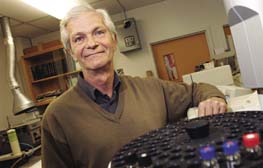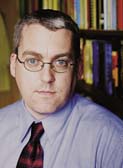The Green Chemistry Revolution (Page 2)
The Green Chemistry Revolution (Page 2) McGill University
User Tools (skip):
The Green Chemistry Revolution (Page 2)
Taking Advantage of Nature
Work on fundamental chemical reactions could take years to translate into industrial processes that will not harm the environment. In the meantime, we're still tossing waste into the air, soil and waters. "When the American Chemical Society defines green chemistry, it does not include waste treatment," says Civil Engineering professor Jim Nicell. As long as we create waste, we have to treat it - and some processes are better than others.
Some of Nicell's research focuses on using natural proteins and enzymes to create treatment processes. "I'm taking advantage of what nature does best by taking certain components of the metabolism of an organism and adapting them to a particular need."
These efforts are turning up some enzymes that may work well in some of the fundamental processes concerning upstream researchers such as Li and Auclair. Nicell has also collaborated with David Cooper of the Department of Chemical Engineering to investigate the degradation of plasticizers, compounds found in many plastics (for example, making up 40% of polyvinyl chloride, widely used as a building material in construction).
"Plasticizers make that new car smell," says Nicell. "They allow for flexibility and workability." North American industry creates about 200 million tons a year of plasticizers, and tests have shown them to be non-toxic and degradable. "But saying that a compound is non-toxic and disappears in the environment," Nicell points out, "does not confirm that there is no environmental impact. For years we tracked how plasticizers degrade when exposed to micro-organisms, and we found that the material was breaking down into products that were not stable in the environment and were much more toxic than the plasticizers. If the environment is assimilating 200 million tons of this material annually and transforming it into toxic products, we could be adding one more element to the toxic soup that is influencing the health of organisms."
And toxicity is only one aspect of the problem. "One of the major classes of plasticizers, phthalates, has been identified as an endocrine disrupter," says Nicell. In this case, non-toxic compounds affect the body as if they were hormones. "So endocrine disrupters switch processes on or off at the wrong time, changing the development of the organism, which is serious," he explains.
Nicell and Cooper are now beginning a research project with three other members of the Department of Chemical Engineering - Richard Leask, a biomedical engineer, Milan Maric, a polymer engineer, and Viviane Yargeau, an environmental engineer - to create a green plasticizer that is easily produced and environmentally safe.
"Research in the environmental area can be a bit depressing," says Nicell. "It's rare to come across good news, and we're discovering problems at a much higher rate than we're solving them. But we can only benefit from the knowledge we're gaining."
There is still plenty of work to be done. For instance, Yargeau is investigating the degradation of pharmaceuticals in waste water and is building links with local industry. "There are lots of ways industry can contribute to research," she says. "For example, pharmaceutical companies could tell us which pharmaceuticals are most difficult for them to remove from their solutions, so we could focus our research on ensuring these chemicals aren't released into the environment."
While remediation research - the business of cleaning up - is increasingly urgent, the field is not new. Professor William D. Marshall, Chair of Food Sciences and Agricultural Chemistry at Macdonald Campus, has worked in this area for many years. But green chemistry offers something special, he stresses. "It's very much a new mindset. I'm very enthused about using these principles to guide what we ought to be doing - and ought not to be doing."
One advantage is the shift in perspective. Rather than simply imposing a list of "thou shalt nots" upon chemists, green chemistry provides working guidelines, albeit challenging ones, and a clear sense of purpose. Marshall is currently exploring the use of supercritical carbon dioxide, a high-pressure form of CO2 that has the properties of both liquid and gas, as a medium for taking toxic compounds such as PCBs and converting them into innocuous products, which has clear economic as well as environmental benefits.
"Vacant lots have been abandoned, particularly in urban areas, because people are worried about soil contaminants. But if we could clean them up, the value of the land would shoot up enough to pay for the decontamination."
Interestingly, supercritical carbon dioxide is now being used to extract caffeine from coffee beans before roasting, instead of organic solvents that can leave a small toxic residue in the decaffeinated coffee. The caffeine itself can be recovered and sold to soft drink and pharmaceutical companies. Just another example of green chemistry at work.
Marketing Green Solutions
Green chemistry will eventually yield countless applications, but new approaches need time before they arrive on the market. "There is industry interest," says Jim Nicell, "but people are cynical. For instance, enzymes are currently prohibitively expensive, which is a drawback for any process using them. But a growing community of people who have performed graduate research projects in this area are now making their way to prominent positions in industry, so there will be a change."
These changes are likely to evolve in a predictable set of arenas, according to assistant professor Steve Maguire of the Faculty of Management, who took an undergraduate degree in chemical engineering before his graduate work in administrative studies. His research has investigated how some processes and technologies, particularly toxic substances such as pesticides and DDT, enter and exit the economy.
"A large number of polluting technologies are being replaced by greener ones, but it isn't always a simple case of one product replacing another because it is better," he explains. "Besides competition in the marketplace, you also see a scientific struggle over whether the new approach is really better. And then politicians and activists also are engaged in the battle for public opinion."
Scientific validity is only part of the process, he stresses. Consider, for example, the pulp and paper industry, which used massive amounts of chlorine to bleach paper, despite the hazards to the environment. European governments established norms governing harmful effluents, and if these were not met, the markets wouldn't accept the product. Canadian industry had to bow to what the European market was demanding. Far from hurting the pulp and paper industry, the effort has helped to make it more efficient, and many pulp and paper operations now are considered poster corps for the environmental and economic advantages of green chemistry.
While citizens, politicians and industry can prompt change, scientists and engineers must develop the means to put that public will into action. The labours of green chemists in labs and in the field will eventually help heal the environment - both upstream and downstream - in the real world. Someday soon, we'll wonder how we ever did it any other way.






